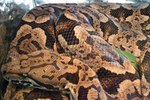
While the majority of snakes lay their eggs in a nest, some of them actually retain the eggs inside of their bodies until they're ready to hatch. Snakes that lay their eggs outside of their bodies are known as oviparous. Those that retain them are called ovoviviparous. Ovoviviparous snakes appear to give birth to live young, but they actually don't -- although there are those who do, known as viviparous snakes.
Lay Them and Leave Them
Around 70 percent of snakes are oviparous and lay eggs in dark, secluded spots, according to the National Geographic website. These spots are usually warm and away from any of the snake's natural predators, so the young can hatch in peace. This is necessary because mom usually won't be sticking around after the young snakes hatch, instead leaving them to fend for themselves. Some snakes, like boas and pythons, are a bit more maternal and will stay, wrapped around their eggs, during their incubation period before they hatch to ensure their safety and warmth. This is a process known as brooding. After birth, though, the young are on their own.
Keeping Them All Inside
While ovoviviparous snakes lay eggs, just like their oviparous counterparts, the mother snake simply keeps those eggs within her body while they incubate. Usually ovoviviparous species, such as some garter snakes and pit vipers, live in cooler climates where it would be harder for the mother snake to properly brood the eggs to keep them warm enough to hatch. By keeping them inside, she can maintain them at a comfortable temperature. Unlike viviparous species, there is no transfer of fluids between mother and babies, because they each feed on the substances contained in their individual eggs. Babies emerge from the mother when they hatch from their eggs, giving them the appearance of "live" births.
And Babies Make ... More Than Three
The gestation periods for oviparous snakes are generally longer than those of ovoviviparous ones and vary from a few weeks to a few months in length. Certain snakes are even capable of reproducing asexually without a male, such as the flower pot snake, boa constrictor and some pit vipers, according to the LiveScience website. While some snakes, like small pit vipers and coral snakes, may lay just two to four eggs in a clutch, others may lay up to 100 eggs or more at a time. Snake eggs are soft and leathery. The hatchlings bite their way out of these soft eggs with a special tooth that they lose soon after birth.
Look, Ma -- No Eggs
While ovoviviparous snakes are sometimes classified as viviparous because they give birth to live young, these young are technically born from eggs. Truly viviparous snakes give birth to live young that are contained within a placenta, not an egg, during their incubation within the mother's body. Snakes like some types of boas, pipesnakes and water snakes are viviparous. Whether they give birth to eggs or live babies, most snake moms won't care for their young, although some will actually stay for the first couple of days or weeks of their lives to protect them from predators.
References
- Idaho Public Television: Snakes
- Newton -- Ask a Scientist!: Viviparous Snakes
- BBC: Ovoviviparous
- BBC: Egg Layer
- The American Naturalist: Viviparity in Snakes: Some Ecological and Zoogeographical Considerations
- Science Encyclopedia: Ovoviviparous
- Science Encyclopedia: Oviparous
- National Geographic: National Geographic News: Snake Wranglers
- The Kid's Directory: Snake Safety and Awareness for Your Family
- Kidzone Fun Facts for Kids: Hey Baby!
Resources
- Animal Questions: Do Snakes Lay Eggs?
- Small Animal Care and Management; Dean Marvin Warren
- Davidson College Biology Department: General Information on Pitvipers
- ScienceDaily: Boa Constrictors Can Have Babies Without Mating, New Evidence Shows
- LiveScience: Virgin Births May Be Common in the Wild
- Science Encyclopedia: Viviparity
- MadSci Network: Re: Are There any Snake Species that are Viviparous
- Snakes: The Evolution of Mystery in Nature; Harry W. Greene
Photo Credits
-
Jupiterimages/Photos.com/Getty Images
Writer Bio
Based in Las Vegas, Susan Paretts has been writing since 1998. She writes about many subjects including pets, finances, crafts, food, home improvement, shopping and going green. Her articles, short stories and reviews have appeared on City National Bank's website and on The Noseprint. Paretts holds a Master of Professional Writing from the University of Southern California.




